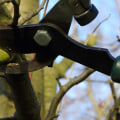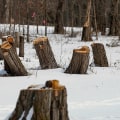It is generally recommended to prune a tree when it is inactive if there are large branches to remove; that is, pruning between the time when the leaves fall off the tree in autumn and the time when the buds swell in spring. But is it a good idea to prune trees in summer? The answer is that it depends. There are certain trees that should always be pruned in summer, certain trees that should never be pruned in summer, and unavoidable situations where you need to prune a tree no matter what time of year you are in. The best time to prune live branches may depend on the desired results.
Growth is maximized and defects are easier to see on deciduous trees if pruning of live branches is done just before growth resumes in early spring. Pruning when trees are inactive can minimize the risk of pest problems associated with wounds and allows trees to take advantage of the entire growing season to begin closing and compartmentalizing wounds. Some tree pathogens, such as the oak wilt fungus, can spread if pruning wounds occur when the pathogenic vectors are active. Susceptible trees should not be pruned during periods of active transmission.
Trees with Dutch elm disease should have symptomatic branches removed as soon as a branch shows flag. Susceptible and uninfected elms should not be pruned during the growing season in regions where this disease is a problem. Being fit during the summer is healthy for people and trees alike. Although the best time to prune any plant is usually in its dormant phase, trees will also benefit from a good mid-season pruning. You must know how much can be pruned when the tree is barely growing and has to adapt to a new environment.
Overdrying: Summer temperatures and the intensity of the sun will cause it to dry out too much if a tree is pruned significantly. Be sure to cut a few inches off the stem or main branches to leave as much nutrients to the tree to survive summer and winter. Usually, it is best to prune trees in the dormant season when deciduous trees have no leaves. If the tree seems stressed in the summer or early in the season, pruning it could help keep it healthy, as it will have less foliage to maintain. These evergreens retain much of their foliage during fall and winter, so pruning them when needed won't affect them.
On the other hand, pruning or pruning to remove dead and decaying branches will make fruit trees healthier and may increase yield. Intense pruning should only be done in summer if the tree is too large, has a dense crown or if you want to restrict its size. But the removal of healthy branches should only be carried out in the middle of winter, the dormant period, when the tree is essentially asleep, or in the spring, when the tree has just started to actively grow again and a new growth is being formed naturally. Safety: Professionals have the personal protective equipment needed to safely climb and prune trees without causing damage to nearby structures. So if you're wondering if it's okay to prune trees in summer, you just have to know that summer pruning is mainly for shaping and creating a solid structure. Since you never know when that may be, it is always better to cut off a dead branch from a tree as soon as you notice it, so that it does not fall on a person or structure at a later date.
It is recommended to prune a transplanted tree in summer to reduce the stress needed to grow or maintain foliage under the hot summer sun.


